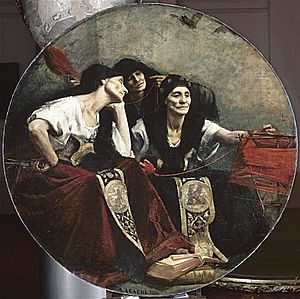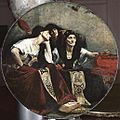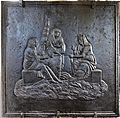Parcae facts for kids
In Roman mythology, the Parcae were powerful goddesses who controlled everyone's destiny. People often call them the Fates in English. They were like the Moirai in Greek mythology. The Parcae held the "thread of life" for every person, whether they were mortal or immortal. Even the mighty gods were afraid of the Parcae and their decisions.
Contents
The Three Fates and Their Jobs
There were three Parcae, and each had a special job related to the thread of life:
- Nona (like Clotho in Greek myths) was the youngest. She was the one who spun the thread of life onto her spindle. This thread represented a person's birth and the start of their life.
- Decima (like Lachesis in Greek myths) was the one who measured the thread of life. She decided how long a person would live and how many adventures they would have.
- Morta (like Atropos in Greek myths) was the oldest and most feared. She was the one who cut the thread of life, choosing when and how a person's life would end.
Ancient Discoveries About the Parcae
The oldest known records about these goddesses are three small stone markers, called stelae or cippi. They were found near an ancient city called Lavinium after World War II. These markers have an inscription that says:
Neuna fata, Neuna dono, Parca Maurtia dono
This old writing mentions two of the three Roman Parcae by name: Neuna (which means Nona) and Maurtia (which means Morta). It shows how they were linked to the idea of fata, or fate.
One of the famous ancient writers who wrote about the Parcae was Ovid. He mentioned them in his long poem, Metamorphoses.
Related Goddesses in Other Cultures
- The Norns are similar goddesses in Norse mythology. They also controlled destiny and the lives of people and gods.
Images for kids
See also
 In Spanish: Parcas para niños
In Spanish: Parcas para niños




